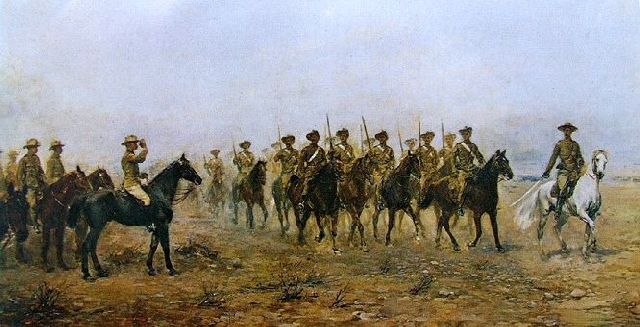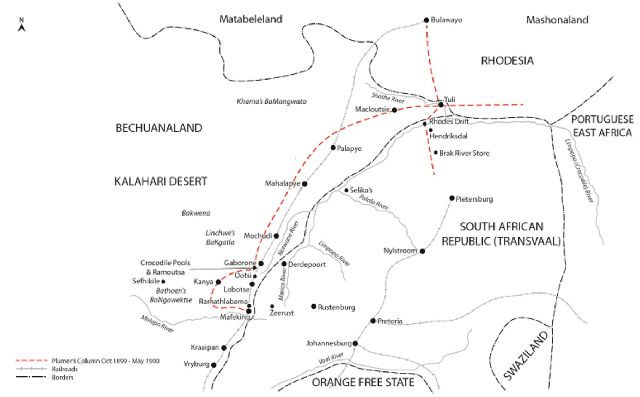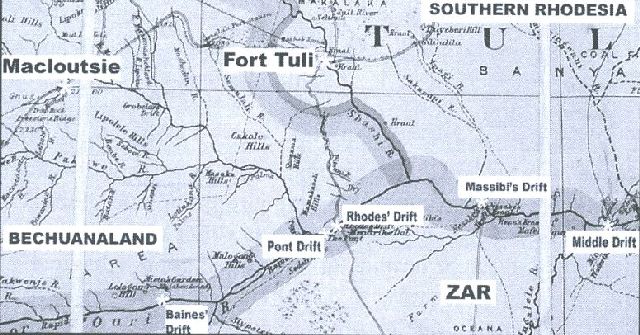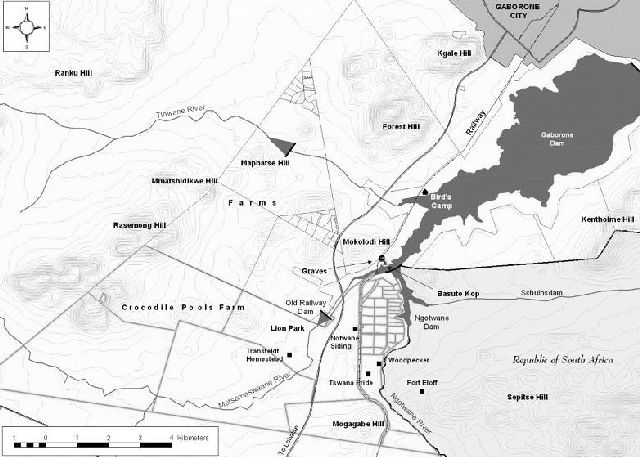

 The South African
The South African
By Graham R. Winton, Cambridge

"E" Troop Rhodesian Regiment before Major-General Baden-Powell,
17 May 1900 upon the Relief of Mafeking, by G. Lindemere, 1901.
National Archives of Zimbabwe.
The history of the Northern Anglo-Boer War has been dominated by Brevet Colonel R.S.S. Baden-Powell (“B-P”) and the siege of Mafeking (Mafikeng), to the near exclusion of his subordinate, Brevet Lieutenant-Colonel Herbert Plumer and his Field Force.
B-P was posted to South Africa to raise a North West Frontier Force in preparation for a raid into the Northern Transvaal, reminiscent of the Jameson Raid (1895-1896) and to defend the Protectorates of Bechuanaland (Botswana) and Rhodesia (Zimbabwe). An area probably of no strategic importance to the Boers, but their first acts of the war took place in Bechuanaland attacking British communications. When B-P moved into Mafeking, Plumer was given command of all the forces in Rhodesia, crucially remaining in the field with his Rhodesian Mounted Rifles Regiment, members of the British South African Police and volunteers.
Kruger's telegrams highlight the anxiety raised by Plumer's small force, commenting 'Watch Plumer at all costs' and questioning, 'Where is Plumer?' and 'Watch Ramathlabama' (Baden-Powell, 1933, pp.201,211). Plumer moved to Fort Tuli (Thuli) on the Transvaal border where his force was bested in several small actions although ultimately frustrating any further Boer incursions into Rhodesia. Plumer then moved his force to the Gaborone region of Bechuanaland, taking command of all forces in the two Protectorates, ‘with a view of endeavouring to relieve Mafeking’. The force was involved in frequent engagements mainly around the strategically important railway line about 776 km long from Mafeking to Bulawayo in Rhodesia. . The force took heavy casualties at Ramathlabama close to Mafeking, before taking part in its successful relief in May 1900 (Plumer’s Evidence, RCWSA, Q17949-Q17950, pp. 334-335).

Plumer's Campaign 1899-1900 (Courtesy Helion Co Ltd)
It is about 805 km from the junction of the Rhodesian, Portuguese East African and Zuid Afrikaansche Republiek (ZAR) [Transvaal] borders to Mafeking, with the Limpopo or Crocodile River forming the boundary. The defence of about 322 km of this frontier devolved onto Plumer's Column, centred on Fort Tuli before he moved to the Gaborone area and southward towards Mafeking. Fort Tuli lies on the Shashi (Shashe) River about 129 km south of Bulawayo and 32 km north of the Limpopo, the northern boundary of the Transvaal. Tuli was therefore a possible launch pad for Imperial raids across the Limpopo drifts such as Baines', Pont, Rhodes' and Massibis'. Gaborone was a strategic point on the north-south railway line close to the ZAR border. Mafeking was a strategically important point on the frontier only 257 km from the ZAR capital of Pretoria on the junction of roads and railways from Johannesburg, Kimberley, Cape Town and Bulawayo. Mafeking was an administrative, political, commercial, communications and psychological hub, for the Bechuanaland Protectorate and north-eastern region of Cape Colony; significantly, also the centre of colonial administration for the BaMangwato, BaKgatla and BaNgawektse native peoples. Its loss could have posed a considerable risk to British prestige and power in the area, culminating in a native rebellion. Full of stores, equipment and railway material, Mafeking was an obvious target for the Boers (Powell, 2004, p.63; Will & Dent,1972, p.195; Amery, Vol.IV, p. 199; Plumer’s evidence, pp. 334-335).
Patrolling the 805 km border was beyond the capacity of B-P's small frontier force. Following the Matabele rising of 1893-4 and the bloody Matabele/Shona rising of 1896-7, Rhodesian settlers feared another native rising, if, as happened in 1895, the Protectorate was denuded of its defensive forces when they were taken for the disastrous Jameson Raid, an invasion of the ZAR, launched from near Mafeking. These fears meant that B-P took a significant risk if he moved his force away from the main areas of native settlement. He stated that what was 'impressed upon him more than anything else’ was to use his forces, 'to keep the natives in order' should hostilities break out or become imminent, to discourage them from rising again and from supporting the Boers. The Jameson Raid further soured relations between the ZAR and Britain, engendering a fear of more invasions launched across their northern frontier. Lieutenant-General Sir William Butler, Commanding Officer for the Cape, stated that, 'in essence the Boer position was one of suspicion ... that they were going to have a repeat Raid or series of raids, for which they had not been prepared in 1895-96. The Boers we knew were in a state of constant watchfulness and alarm all along that frontier at that time'. This fear was not misplaced (B-P's Evidence RCWSA, pp. 423-424,426; Butler’s Evidence RCWSA, Q13585, p. 83; TNA(UK). General Wood's Orders to Baden-Powell, 7 July 1899).

Map showing the five drifts
Certainly, from May 1899 the War Office Intelligence Department had been 'enquiring' into the possibility of a "raid" into the northern Transvaal from Macloutsie (Motloutse) or Fort Tuli seizing Pietersburg then Pretoria. By continually menacing the back door of the Transvaal a considerable force of Boers in the Waterberg and Zoutpansberg districts could be contained and prevented from moving south. On 1 July 1899, the War Office Intelligence Department forwarded to Field Marshal Viscount Wolseley, Commander in Chief of the Forces, a lengthy secret Memorandum, 'On the project of a raid from Southern Rhodesia on the Northern Districts of the Transvaal in the event of war with the South African Republic'. A note in the margin read, 'Kindly avoid use of this ill-omened word "raid"'. The project was probably conceived by Captain J. S. Nicholson, Commandant-General of the British South Africa Police (BSAP) and from 1898 Inspector-General of Volunteers in Rhodesia, and directly responsible to Sir Alfred Milner, High Commissioner South Africa, for all the armed forces in Southern Rhodesia both police and volunteers. The Intelligence Department recommended to Wolseley that B-P be ordered immediately to Bulawayo, landing at Beira (Portuguese East Africa, now Mozambique), with Tuli or Macloutsie as the probable rallying point. Orders had already been issued to Nicholson through the Colonial Office for the purchase of horses and military equipment for the field force (TNA (UK), Memorandum, 1 July 1899).
On the 3 July 1899, B-P was appointed for Special Service in South Africa, accompanied by a small group of ultimately 25 Imperial Special Service Officers. He states that the duty of his force was to "hold the frontier on the west of the Transvaal from Vryburg in Cape Colony to Bulawayo in Rhodesia", some 1,046 km, with a mobile force of two regiments of mounted rifles and about 400 police, but no regular troops (Baden-Powell, 1933, p.201). He was to raise, equip and train this Special Service Corps of two mounted regiments of irregular horse under the Cape Colonial Forces Act. The Rhodesian Mounted Rifles Regiment was placed under Lieutenant-Colonel Plumer (arrived Bulawayo 8 August) and the Protectorate (Bechuanaland) Regiment, under Lieutenant-Colonel Hore. These regiments were to form the nuclei of stronger forces with the addition of Nicholson's BSAP and volunteers. All the armed forces in Rhodesia and Bechuanaland were therefore under B-P's command, a North West Frontier Force of about 1,000 men. B-P's mission was considered secret even though it had been reported in the local Cape newspapers. Special service officers were to wear civilian clothes and travel to Bulawayo under false names, keeping their exact destination and mission quiet, until reaching Rhodesia (NLCT, Queenstown Free Press, 4 August 1899).
Rhodesian Forces
Within the space of three months men were enlisted from different parts of Cape Colony, Natal and Rhodesia. Supplies and transport were arranged, with little help from Lieutenant-General Butler or local Government. B-P wrote that, ‘The ordinary training of a soldier, even with everything ready found, usually takes at least twelve months ... The marvel is that although we only started in July, we had our force ready for service and in the field when war was declared by the Boers on 11 October 1899’ (Hanbury-Tracy, File One, p.2).
The men were to be enlisted for three month's service, but should war be declared their services 'may be retained for a further period of six months' (TNA (UK), WO32-7852, July 1899). So as not to antagonise the ZAR or attract Boer forces to Mafeking, B-P was prohibited from recruiting in Cape Colony or using Mafeking as a base or concentration point during peacetime. Recruitment from the small Rhodesian settlements was limited; many Rhodesian recruits chose to remain in their civilian employment until the actual declaration of war. To accommodate this, an additional troop of local volunteers was raised and trained, designated E Troop, Rhodesian Regiment and called to active service when war broke out (Hickman, 1970, p.74). Recruitment was mainly from coastal ports and near-coastal towns such as Graham's Town, King William's Town, East London, Port Elizabeth, and Cape Town, as well as from Kimberley to the north (NLCT, Cape Times Weekly Edition 30 August 1899, 2 and 6 September 1899). Equipment was acquired from Army Ordnance and the BSAP. By the end of September, the regiments were each of about 450 men, engaged to the end of September 1900, when both regiments were disbanded. Recruits came from a wide variety of civilian trades and employment including some ‘ne'er do wells and adventurers’ and some with previous military or police experience. B-P stated that, ‘They were a very mixed lot. They did very well on service; they would never have done in peacetime’ (B-P Evidence RCWSA, Q19844, p.423-4; Plumer Evidence RCWSA, Q17953, 17957, 17959, 17860; Godley Letters, 5 September 1899, p.9).
Plumer’s Rhodesian Regiment was based in Bulawayo before moving to Fort Tuli; Hore’s Protectorate Regiment, until moving into Mafeking, was based at Ramathlabama, 29-32 km north of Mafeking in the Bechuanaland Protectorate.
B-P was aware that his total force would be too weak to achieve anything if scattered along the whole 805 km border and had requested additional guns and mounted men. This request was refused. He therefore split his total force (about 2,000 men) into three 'forces', which, crucially, remained in communication with one another throughout the campaign. On 4 October, B-P personally took command of all forces in Mafeking, including the Protectorate Regiment. Plumer, in command of all forces in Rhodesia, was at Fort Tuli until January 1900 when his Column moved to the Gaborone area and he took direct control of all forces outside of Mafeking, which included a small independent Rhodesian Force, the Palapye Column, organised by Colonel J. S. Nicholson based in Bulawayo (Hanbury-Tracy, 'The Siege of Mafeking; Plumer Evidence RCWSA, Q17949, p.334). B-P refers to a pretend “Third Force” between those of Plumer and Mafeking, which ‘did not exist’ but I believe is the ‘Palapye Column’ (B-P Evidence RCWSA, Q19871/19872, p.427).
This Palapye Column, which included members of the BSAP, Southern Rhodesian Volunteers (SRVF) and armoured trains was placed by Nicholson, under the command of Lieutenant-Colonel Holdsworth, along the southern railway line down to the Gaborone area. The last units to join Plumer, in May 1900, in time for the relief of Mafeking, were elements of the Rhodesian Field Force under Lieutenant- General F. Carrington. In addition, several independent local defence corps were established or strengthened in many of the small railway towns such as Vryburg, Mafeking, Lobatsi and Francistown (Burrett, June 2002, pp. 78-82; Stirling, 1907, p. 201).
The Palapye Column was placed at the most important points for holding the border south of Bulawayo and safeguarding the north-south railway line. Plumer, with command of the northern forces, was given responsibility for keeping communications open to the north and north-west, to induce the Boers into detailing a strong force to protect their northern district, to block any attempted Boer invasion of Rhodesia and if necessary, to advance into the Transvaal itself. No portion of Plumer's force was to cross the frontier until he received orders to that effect (Powell, 2004, p. 59; TNA (UK) WO32/7852 -W079/8693, 5 July 1899). Boer commandos were issued with a similar order. B-P ordered Plumer to 'act for the best according to what news you receive from Natal etc ... and not await my orders. I will endorse your action' (BLM, Weil Papers, 20 October 1899). An advanced party of the BSAP prepared defences at Tuli, during early August, including construction of a telegraph line linking Rhodes Drift and Fort Tuli. By 11 October Plumer and his Column, some 550 men (420 Rhodesian Mounted Rifles,100 BSAP already at Tuli, later joined by 50 SRVs from Bulawayo), was located at Fort Tuli and the various drifts on the Limpopo, to counter Boer forces at Hendriksdal and the drifts. Plumer was disadvantaged in artillery for much of the campaign and outgunned by the Boers; his guns were of various types, mostly old patterns and ineffective. He was supplied by Nicholson, via supply ships from Durban and Port Elizabeth to Beira, then by rail and ox- wagons to Bulawayo and Fort Tuli, over 2,414km. Prior to the outbreak of war, Nicholson stockpiled stores in Bulawayo and six weeks’ supplies at Fort Tuli. Plumer decided to concentrate on three of B-P’s instructions, to "defend the border", "display strength" and to "create diversions..." (Plumer's Evidence RCWSA, Q17950, p.335, Q18061; Hickman, 1970, p. 95).
Commando Forces
From 5 October, regionally-based district Boer commandos began concentrating on four main camps along the Limpopo River, with their railhead some 241km distant at Pietersburg. Under the joint command of Commandant-General Frederik Albertus Grobler and van Rensburg was the Zoutpansberg Commando, about 1,287 men while the 732 men of the Waterberg Commando were directly under Commandant-General Grobler. Under the direct command of General Pieter J. Cronjé were the Rustenberg Commando, 2,536 men under du Plessis and Piet Kruger and the Marico Commando, 1,265 men, under Veld-Kornet Pieter Daniel Swart. Also with Cronjé were the Potchefstroom, Lichtenburg, Wolmarransstad and Bloemhof Commandos. Cronjé later handed over command to Kootjie Snyman (Hickman, 1970, pp. 47-48; Burrett, 2009, pp. 53-54).
The Zoutpansberg Commando gathered on 11 October, at the Brak River Store some 50 km south of the Limpopo with their main camp at Hendriksdal Farm, 4km from Rhodes Drift. The Waterberg Commando also gathered on 11 October, at Nylstroom, before moving to near Selika's (opposite Ngwapa now Groblersburg) at the junction of the Limpopo-Palala rivers, confronting Kgosi Khama's Ba-Mangwato people. The Rustenberg Commando was concentrated at Derdepoort confronting Kgosi Linchwe's BaKgatla people. The BaSeleka were a small native group straddling the Limpopo and Boer allies since the 1880s. The BaMangwato and BaKgatla peoples were pro-British (Parsons, Q.N, 1973, pp.184,187). The Marico Commando were in several small encampments close to the border opposite Lobatsi, for example, at Gopanistad (Maanwane), Ikalfenstad or Skalfienstad and near Malmani, confronting Gaborone and Mafeking. The first Boer patrols and posts were established along the Limpopo by the 16 October.
Estimates of Boer numbers fluctuate widely over the period of the campaign, as a flexible command structure meant not all men were active in commandos at any one time (Godley Letters, 4 October 1899, pp33-34). By the 19 October Boer forces had reached their full strength, probably a maximum of 1,500 burghers faced Plumer and around 6,000 in the Mafeking area, although this number could have been as high as 7-10,000 and as low as 3,000. Fortunately for Plumer friction and disagreements amongst Boer leaders and Commandos meant a reluctance to participate jointly in serious action or to cross the border in any force (Jeal, 1991,pp 218, 245; Burrett, June 2002, pp. 78-82; B-P's Evidence RCWSA, Q19899, pp.423-424).
War declared
With the declaration of war on 11 October, the first acts of hostility took place on the Bechuanaland border with two immediate Boer incursions on Bechuanaland communications, cutting the Cape-Rhodesia telegraph wire just south of Mahalapye in Bechuanaland (12 October) and capturing an armoured train at Kraaipan (13 October) 50 km south of Mafeking in Cape Colony. Between 12 and 17 October, the Marico Commando cut the telegraph line and ripped up the rails at Ootsi, (Otse), destroyed the railway bridge at Ramathlabama and captured Lobatsi, effectively cutting the railway line between Mafeking and Gaborone (Parsons, N, 1999, p. 45).
The Boer High Command intended the Marico Commando with reinforcements from the Rustenberg Commando and from Mafeking to drive northwards joining the main Rustenberg Commando around Mochudi. They were then to drive north joining the Waterberg Commando before entering Rhodesia via Fort Tuli and linking up with the Zoutpansberg Commando, which was engaging Plumer (Parsons, N, 1999, pp.44-45; Parsons, Q.N., 1973, p.186). The Waterberg Commando failed to achieve its important task of capturing or destroying the strategic northern section of the railway line. This failure proved to have a serious strategic impact as it prevented any further serious Boer advance to take Bulawayo.
Trains
The Palapye Column confined itself to keeping open as much of the railway line between Bulawayo and Mafeking as possible, with the use of several armoured trains crewed and supported by a small independent force of railway employees, BSAP, Protectorate Native Police and volunteers. During September, Nicholson had requested six trains be converted and armoured by the Rhodesia Railway workshops in Bulawayo. Two were sent to Mafeking; the remaining four, including a construction support train, were retained for use from Bulawayo. Each armoured train consisted of an engine and a wagon with a mounted maxim gun and/or a 7-pounder gun on a raised platform. The trains ran in pairs, one always in support with the construction train close behind to repair any damage to the railway. The trains proved decisive in protecting the railway, spearheading Rhodesian thrusts southwards and supplying Plumer's advance towards Mafeking.
From October 1899 to January 1900, invading Boer forces controlled much of the southern border area of the Bechuanaland Protectorate, having besieged B-P in Mafeking and either put to flight or captured units stationed in outlying places. Much of the action during October and November 1899 took place along the rail line around Mochudi to Gaborone and Crocodile Pools (Ngotwane Siding), a distance of about 63km, then south towards Mafeking, involving two of the armoured trains and artillery positions on the fortified hilltop strongholds along Sepitsi Hill. On the 18 October, a few miles north of Lobatsi, one of the armoured trains engaged and pushed back the Marico Commando. A similar incident occurred at Ramoutsa on the 21 October. However, on the 24 October the Rhodesians fell back to Mahalapye, evacuating Gaborone and Crocodile Pools, which were then occupied by the Boers as was Mochudi station from 31 October to late November. Nicholson responded by sending reinforcements of some 350 BSAP and SRV, with two additional armoured trains, from Bulawayo to Palapye and Mochudi. In a significant and controversial action on the 24 -25 November, Holdsworth and the BaKgatla crossed the Marico River into the Transvaal, attacking the Marico Commando laager at Derdepoort. This intervention in a 'white man’s war', was followed by bitter conflict between the BaKgatla and Boers in the Rustenburg District, independently of British control, but invaluable in insulating the north-south railway from attack until 1902 (Parsons, Q. N, 1973, p. 186).
Following the action at Derdepoort the Boers abandoned their positions around Gaborone, wrecking the important railway bridge over the Metsemaswaane (Metsi-masauna) River near Basuto Kop. The Rhodesians re-occupied Gaborone on the 12 December, repairing the damaged railway line, bridges and culverts, before retiring to Mochudi. Patrols continued southward but the Gaborone area was effectively abandoned until January 1900. Most Boer strongholds were probably erected about this time in the narrow pass near Ramoutsa Siding south of Crocodile Pools and along the prominent Sepitsi Hill on the Transvaal side of the border. The largest fortification was Fort Eloff, with several small outposts on Mogagabe Hill within the Protectorate itself, blocking any Rhodesian advance towards Mafeking. Patrols and small-scale skirmishes continued during this period.

Gaborone-Crocodile Pools Area.
Courtesy of Michael Brook.
Acknowledgements
This article is based on a paper given at the 120-Year Commemoration of the Anglo-Boer (South African) War Conference held at the War Museum in Bloemfontein, South Africa, 9-11 October 2019. I am indebted to Robert Burrett for sharing his extensive knowledge and research on the North West Frontier Campaign; to Tim Jeal and Michael Brook; James Nicholson for allowing access to the private papers of Major the Hon. A Hanbury-Tracy; Brian Willan for loan of the Godley Letters; Najwa Hendrickse, Ronel Rogers, Malanie Geustyn and staff of the National Library of Cape Town.
To be continued ...
Bibliography
Amery, L.S, (ed), The Times History of the War in South Africa (7 volumes). London: Sampson Low Marston, Vol IV.
Baden-Powell, R, Evidence before the Royal Commission on the War in South Africa, Cd.1792, Vol. II, 19 March 1903.
Baden-Powell, R, Letters from the Varsity of Life (London, 1933).
Hickman, A.S, Rhodesia Served the Queen, (Salisbury: Rhodesian Army, 1970), Vol.1.
BLM: British Library (Manuscripts), Weil Papers, Volume III 46850, Document 11-12, Message to Plumer from B-P via Nicholson, 20 October 1899.
Brook, M.C, Crocodile Pools Botswana: History and Biodiversity (Botswana 2011).
Burrett, R, ‘Events in the Tuli Area, Part One', South African Military History Society Journal, Vol.12, No.3, June 2002, pp. 78-82.
Burrett, R, Plumer’s Men, (Just Done Productions), Durban, 2009.
Butler’s Evidence before the Royal Commission on the War in South Africa, Cd. 1791, Vol. II, 11 February 1903.
Godley Letters:
Hanbury-Tracy Papers: File One, Rough Proof Siege Mafeking, p.2
'The Siege of Mafeking t/s by Captain the Hon Algernon Hanbury-Tracy'.
Jeal, T, Baden-Powell (London: Pimlico, 1991).
NLCT: National Library Cape Town: Queenstown Free Press, 4 August 1899; Cape Times Weekly Edition 30 August 1899, 2 and 6 September 1899.
Parsons, N, ‘Not Quite All Quiet on the North West Frontier: Khama's Bangwato and the Waterberg Commando', South African Military History Society Journal, 41, November 1999.
Parsons, Q.N, ‘Khama III, the Bamangwato and the British: with special reference to 1895-1928'. (Unpublished PhD Thesis University of Edinburgh, 1973).
Plumer’s Evidence, before the Royal Commission on the War in South Africa, Cd. 1791, Vol. II, 12 March 1903
Powell, G, Plumer: The Soldier's General (Pen & Sword Military, 2004).
TNA (UK). The National Archives (United Kingdom):
(i) General Wood's Orders to Baden-Powell, 7 July 1899, WO 32/785.
(ii) WO32/7852 -079/8693, ' Memorandum on the project of a raid from Southern Rhodesia on the Northern districts of the Transvaal in the event of war with the South African Republic', 1 July 1899, prepared by Colonel W. Everett for the Department Military Intelligence and Secretary of State for War, 1 July 1899.
(iii) WO32-7852, Raising of Special Service Corps Southern Rhodesia, July 1899, WO typed letter to Col. Baden-Powell, marked "B", "Draft Proposals for the Special Service Corps in Rhodesia".
(iv) WO32/7852 -079/8693, Instructions signed by Wolseley 5 July 1899.
Will, D & Dent, T, ‘The Boer War as Seen From Gaborone', in Botswana Notes and Records, Vol.4, 1972, pp. 195-209.
Stirling, J, The Colonials in South Africa 1899-1902 (London, 1907).
Part 2 of this article is scheduled to appear in Volume 19 no 3.
Return to Journal Index OR Society's Home page
South African Military History Society / scribe@samilitaryhistory.org